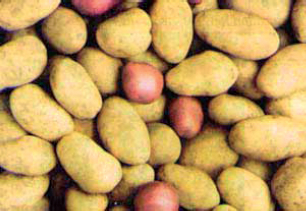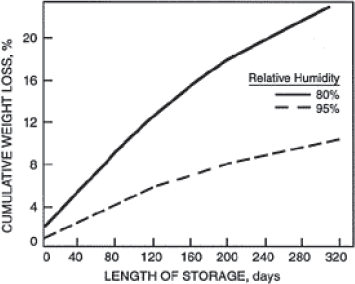Potato Storage
Potato Storage
by Dale D. Moyer
Columbia University

Potato Storage Management
There are great differences among storages in Suffolk County. In addition, conditions at harvest and the conditions of the tubers, factors which vary from year to year influence how potatoes are to be stored. However, maintaining uniform temperature and high relative humidity, removing excessive heat, and providing air movement are some basic requirements which can be applied to all potato storages. Proper storage management practices discourage the development of rot, promote wound healing, retard sprouting, minimize weight loss and maintain tuber appearance and quality.
Storage management must begin long before the first potato is unloaded into storage. Many decisions made in the spring and throughout the growing season influence how well potatoes keep. Factors which affect storageability before the tubers are placed in storage include: crop maturity, chemical vine desiccation, variety, tuber quality, soil moisture and temperature at harvest and the potato harvest and handling operation. These factors must be properly managed to enable you to place a quality product in storage. Remember, the best that can be achieved is to maintain the quality level present at the time of initial storage.
Properly managed potato storages provide an environment to maintain the best possible tuber quality and appearance until the potatoes are sold. To accomplish this there are four basic periods of storage which must be followed: curing, cooling, holding and removal. Each period has a specific function.
The curing period immediately following harvest, often referred to as the suberization of wound healing period, is one of the most important storage phases. Weight loss is highest during the curing period due to moisture loss from cuts and bruises and high respiration rate. As much as two to four percent of tuber weight can be lost in the form of water during the first month. If the storage is managed properly, this water loss can be used to maintain the high relative humidity needed during the wound healing period.
Wound healing is dependent on temperature and relative humidity. Cure sound tubers at a temperature range of 50-60°F with a relative humidity of 95% for 10 to 21 days. Tubers harvested with pulp temperatures lower than 50°F should be warmed to the desired curing temperature. If the relative humidity is low, suberization is poor and a starch layer may form over the bruise, thus preventing healing . Poor suberization encourages rot and excessive moisture loss throughout the storage season.
Uniform air movement is necessary during curing to remove respiration and field heat, to supply oxygen, and to prevent condensation within the pile. If available, a humidifier should beused to maintain the ventilating air at a relative humidity of 95%. Without a humidifier, use only the naturally occurring humid air for ventilation. In a through-the-pile forced air ventilation system, fans should be operated minimally, usually one to two hours/24 hours. This will provide sufficient oxygen and minimize moisture loss. Longer fan operation may be needed to maintain desired storage conditions.
Under good harvest and tuber conditions, suberization usually occurs very rapidly and tubers should be then cooled to the desired holding temperatures. Potatoes affected by freezing injury, Pythium leak, late blight or soft rot quickly develop into wet breakdown at normal curing temperatures. The best alternative for these potatoes is to grade out the rot and sell them immediately. If these potatoes must be stored, lower the temperature as rapidly as possible to 45°F or lower with a low-to medium-relative humidity, depending on the severity of the problem. Under low temperature and relative humidity conditions, the wound healing process is very slow. Air circulation through the pile is very important to: (1) remove the moisture given off by any rotting and frozen tubers, (2) dry off the surface of wet tubers and (3) reduce the spread of decay. Once healing is accomplished, potatoes should be maintained at the lowest practical holding temperatures and marketed as soon as possible.
Immediately after the curing period, begin cooling the tubers down to the holding temperature. Reducing the storage temperature too quickly, followed by a mid-fall warm spell, causes fluctuation of tuber temperatures. Fluctuating temperatures may reduce the storage life and quality of the potato. Cool a maximum 4-5°F per week. Use a pulp thermometer to check tuber temperature. Potatoes should be cooled with humid air no lower than 3-5°F below tuber temperature. Only humid, cool air should be used unless a humidifier is available. Through the pile ventilation achieves rapid cooling; however, dehydration is likely if a humidifier is not used.
 Figure 1. Influence of relative humidity on weight loss during storage at 40 F. (4.4 C) Kennebec potatoes.
Figure 1. Influence of relative humidity on weight loss during storage at 40 F. (4.4 C) Kennebec potatoes.Weight vs. Storage
The holding environment for good quality potatoes should be maintained at a high relative humidity (90-95%) (see figure 1) and temperatures between 38-55°F, depending on the ultimate market of the potatoes. During this period, tuber quality should be preserved by keeping weight loss to a minimum and by controlling sprouting and rot. Temperatures between 38-40°F is the optimum temperature range for sprout suppression. These temperature levels will also control bacterial soft rot, silver scurf, and other storage diseases and minimize the respiration rate. Research has shown that respiration is lowest at a holding temperature of 45°F. If the relative humidity is kept high and sprout inhibitors are used, potatoes stored at 45°F will maintain a physical quality similar to those stored at 40°.
Temperature should not vary by more than 2-3°F from the bottom to the top of the pile or +2°F from the desired holding temperature. Fluctuating temperatures may cause condensation within the pile and accelerate sprouting at higher storage temperatures. A pulp thermometer gives the most accurate temperature readings. However, it is difficult to obtain pulp readings in the pile; therefore, temperature sensors are used in the pile to monitor storage temperatures. Maximum/minimum thermometer and hygrothermographs are helpful in monitoring fluctuating air temperatures. Keeping daily temperature records is important.
Potatoes should all be warmed to 45-50°F before removing from storage to reduce bruising. This can reduce cullage over 2% during the handling, grading and packing. By restricting ventilation, the heat of respiration will increase the storage temperature in a few days. (From Suffolk County Agricultural News, September 1985.)